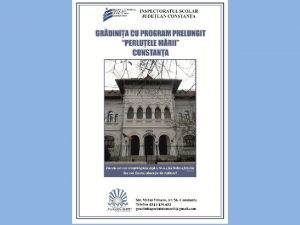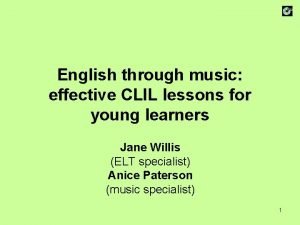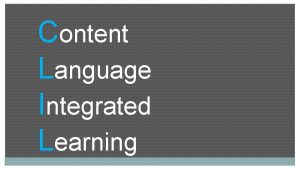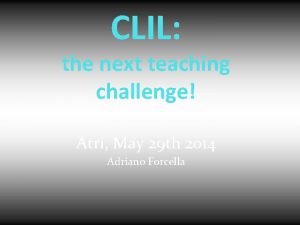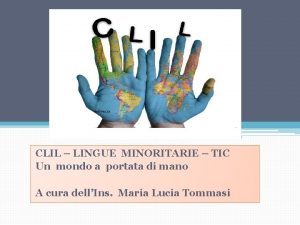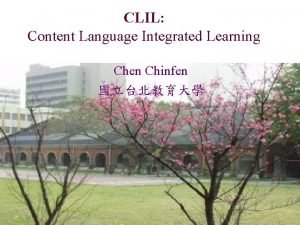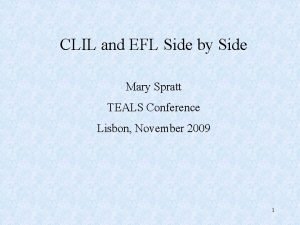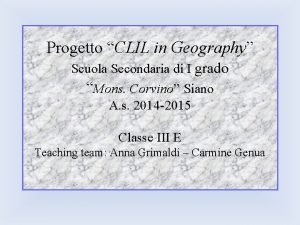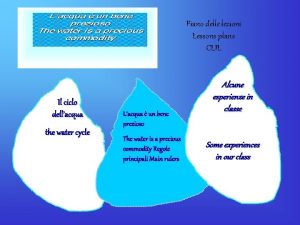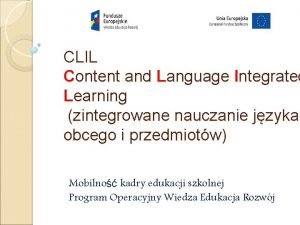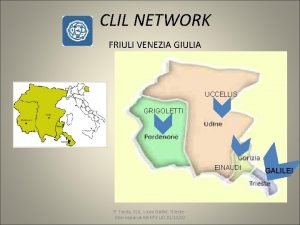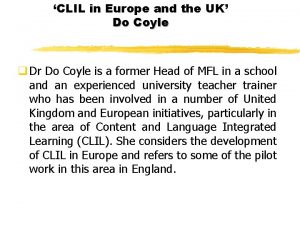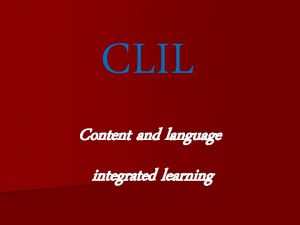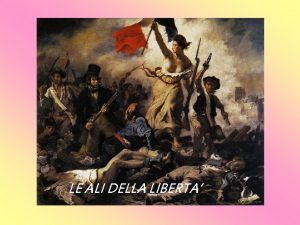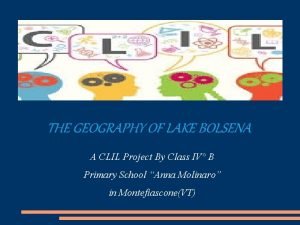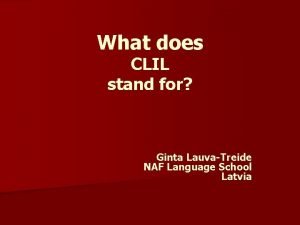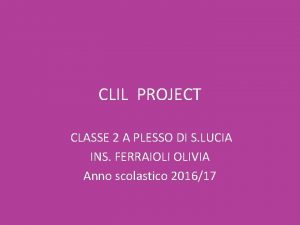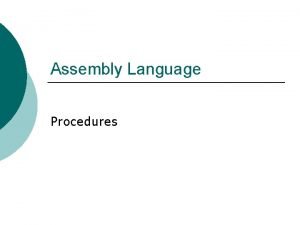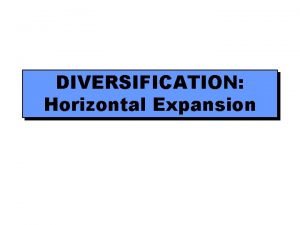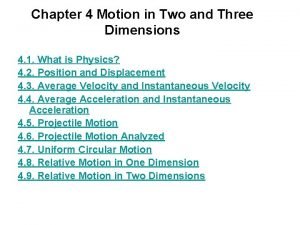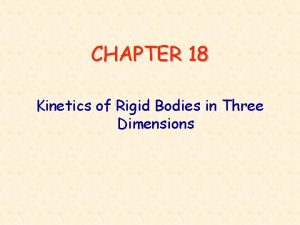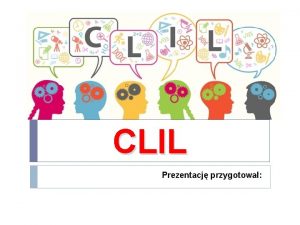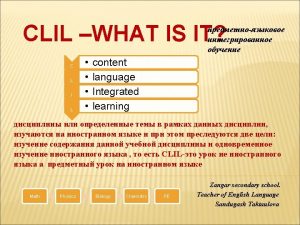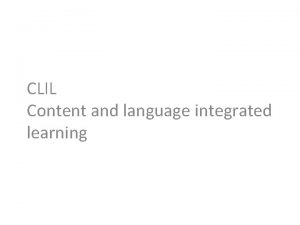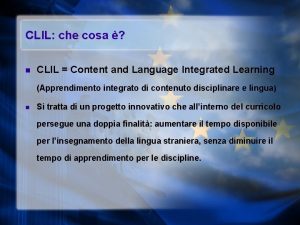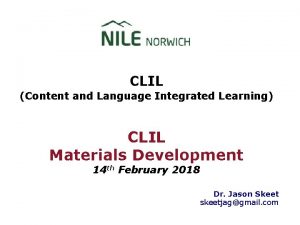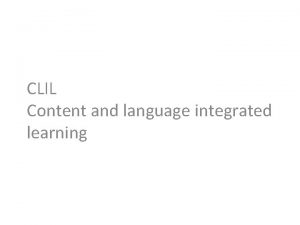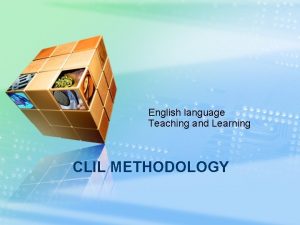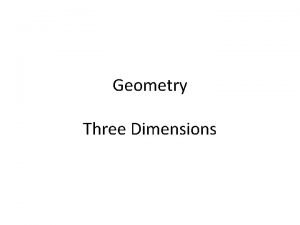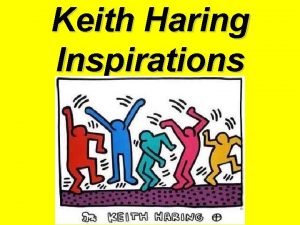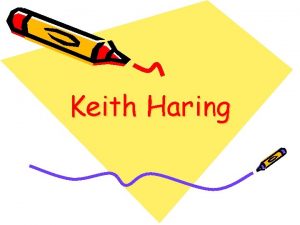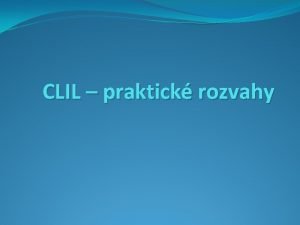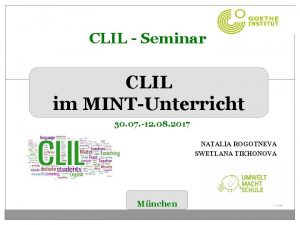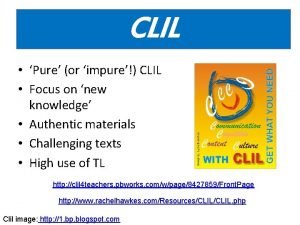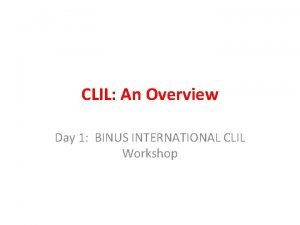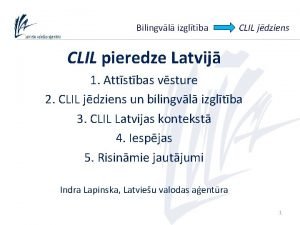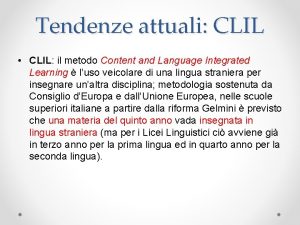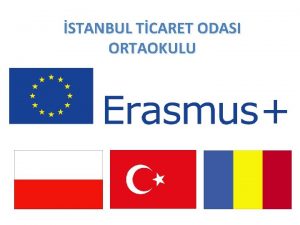Three Dimensions of CLIL concepts procedures language Keith





































- Slides: 37

Three Dimensions of CLIL (concepts, procedures, language) Keith Kelly keithpkelly@yahoo. co. uk

Language, concepts and procedures in school • Thinking skills • Knowledge of academic vocabulary • Knowledge of academic genres (e. g. narrative, instructional, explanatory, persuasive etc) • Academic language skills (speaking, listening, reading, writing about subjects) • Study skills (using books, libraries, internet; taking notes, summarising, planning and executing writing, etc) • Procedural skills (groups, pairs, presentations, lab work, etc)

EU Transversal competences • Communication in the mother tongue • Communication in foreign languages • Mathematical competence and basic competences in science and technology • Digital competence • Learning to learn • Social and civic competences • Sense of initiative and entrepreneurship • Cultural awareness and expression

What do these numbers mean to you? • • 750, 000 650, 000 40, 000 -45, 000 Every 12 th 2500 = 80% 7500 = 90% 10%

Words in the English language • • 750, 000 – words in English 650, 000 – words in OED 40, 000 -45, 000 – used by average speaker Every 12 th – ‘the’ 2500 = 80% of all words we use 7500 = 90% of all words we use (star words) 10% = the rest, topic specific (black words)

Curriculum discourse analysis Task - Identify the ‘black’ words in the text below, there are 12 of them. Infections Food and water are sources of infection. Raw food is covered in microorganisms. Most are harmless or do the body good. They grow in our intestines and protect them from more harmful germs, but others cause disease, especially if food's been contaminated by sewage or animal waste, or hasn't been cooked properly. Contact with animals also exposes us to new microorganisms. A bite from an infected dog could lead to rabies, for example. Cleaning out a lizard's cage could lead to salmonella.

Curriculum discourse analysis Infections

The role of CLIL in the teaching of cross-curricular competences Cross-curricular competences are hard to teach • • • They tend to remain ‘hidden’ and inexplicit Teaching is ‘assumptive’: it assumes learners have them They run counter to the ‘vertical’ organisation of the curriculum Teachers are reluctant to take responsibility for them Teachers are unsure how to teach and assess them CLIL teaches competences explicitly • Learners cannot learn subjects in L 2 unless the language and cognitive skills they require of learners are taught explicitly • It uses explicit pedagogy, collaboration and whole-school management

Language and cognitive skills: Thinking skills in maths Students should be aware of the need to: • Clearly record any observations or strategies • Use appropriate methods to record results or data • State any conjectures and ways of testing or justifying them • Make generalisations • Explain the reasoning behind these generalisations • Make appropriate justifications • Examine and explain any results • Try to offer proofs

The language of learning (BICS & CALP)

Typical thinking skills required by school learning • • • • Defining Classifying Illustrating/Exemplifying Describing place Describing objects Contrasting Comparing Giving reasons Predicting Hypothesising Expressing time sequence Expressing cause and effect Drawing conclusions/deducing

Cognitive skills are realised in language Giving reasons Teacher questions • Why? • Why does/did…? • Who can tell me why…? • What is/was the reason for that? • Give me a reason for that • What will/would happen if…happens/happened? Statements • This is/was because… • The reason for this is that… • There are three reasons for this. • This is/was due to… • This is/was the cause of… • This causes/caused …

Mind mapping http: //cmap. ihmc. us/conceptmap. html

The 4 basic arithmetic operations - Addition: 1+4=5 „ 1 plus 4 equals 5“ - Subtraction 1 -4=-3 „ 1 minus 4 equals negative/minus 3“ - Multiplication – multiplying: 2 H 4=8 „ 2 times 4 equals 8“ - Division – dividing: 1 4=1/4 „ 1 divided by 4 equals a quarter“

Materials science and processing Talking about mechanical properties • Stress and strain: – What are they and why are they used instead of load and deformation? • Elastic behaviour: – When loads are small, how much deformation occurs? What materials deform least? • Plastic behaviour: – At what point does permanent deformation occur? What materials are most resistant to permanent deformation? • Toughness and ductility/brittleness: – What are they and how do we measure them?

Stress and strain

Making language explicit

Describing the filtering cycle

Visually representing concepts

Making language explicit

Vocabulary of thinking

History How far were the German people dissatisfied with the terms of the Treaty of Versailles? (10 marks) Sample answer: The treaty presented to the German Delegation was imposed on them. They had not been allowed to take part in the Conference and considered the Treaty a ‘Diktat’. Some German delegates even considered refusing to sign it. There were many aspects of the treaty that were hated. The Loss of territory including Alsace-Lorraine, for example angered many ordinary Germans. Other countries were allowed self-determination but the Treaty of Versailles forced some Germans to live under foreign rule (e. g. Polish rule in the East). Germany was also not allowed to unite (Anschluss) with Austria. Military restrictions were also placed on Germany and many Germans felt vulnerable to future attack as well as loss of pride. Members of the German armed forces felt particularly angry about this aspect of the Treaty.

History The new Weimar Government had to pay the Allies huge reparations. Many Germans, including business leaders and politicians thought this was unfair and designed to bankrupt the German economy and keep it weak. Germany was also not allowed to join the League of Nations (finally joined in 1926) and many Germans considered this a further insult to their pride. Germany was forced to accept responsibility for starting the War. Most Germans did not accept this and many in the German Army did not think they had been beaten but betrayed by politicians in Berlin who seemed to accept defeat and signed the Treaty of Versailles. This was possibly the most hated part of the treaty. Finally, most of the German people hated the treaty of Versailles and many blamed their own politicians for signing. Most of the German Army thought that France had its revenge and some even wanted to restart the war. Germany had been forced to take responsibility for starting the war, been humiliated by the victorious powers, made to pay reparations, lost one tenth of its territory, most of its military strength and could not unite with Austria.

History – conceptual and procedurual support

How far were the German people dissatisfied …? ‘angered many ordinary Germans’ ‘felt vulnerable to future attack’ ‘felt a loss of pride’ ‘felt particularly angry about this’ ‘thought this was unfair’ ‘considered this a further insult to their pride’ ‘did not accept this’ ‘did not think they had been defeated’ ‘felt betrayed’ ‘was possibly the most hated part of the treaty’ ‘hated the treaty’ ‘blamed their own politicians for signing’ ‘forced to take responsibility’ ‘had been humiliated’ ‘made to pay reparations’

3 D CLIL - conceptual, procedural and linguistic help

History – input to output

Which is the correct graph, why?

Parachute graph 1 MA - Height above the ground over time… We know that when somebody jumps out of a plane that they accelerate at gravitational acceleration which is nine point eight metres per second squared. Now the slope of the graph is the speed that the person is traveling at and the speed will increase at nine point eight metres per second for each second that they are falling MA - So the (what am I trying to say here? ).

Parachute graph 2 MA - The speed, er, if we had a graph of the speed against time it would be a straight line, so a graph of the height against time should be, erm a parabola, I think it has to be D. Why are the others wrong, well C is wrong because that would suggest that the height… What does C suggest? MA - It falls … KK - It suggests he hits the ground doesn’t it … time stops MA - Well, somehow he manages to go from twenty feet above the ground to zero feet in no time. That’s what that graph suggests happens. KK - Yes, that’s C yeah. MA - B suggests that there were two different phases of falling. KK – yeah, there isn’t a slowing…

Parachute graph 3 • MA – Oh, hang on, I haven’t read the question properly… He jumps out of the plane, falls fast towards the ground after a few seconds his parachute opens. He slows down, and then falls to the ground at a steady speed. So, it is B, because the first little bit of the graph is the bit before his parachute opens, the second little bit is the bit after his parachute opens when he’s going slower so it’s a more gradual decline, he doesn’t go through as much, it takes longer to go through the same kind of distance, that means he’s traveling slower. A and D both suggest a gradual slowing down, not an abrupt change with the parachute opening. • KK – Yeah, brilliant, OK?

Explanation language analysis 1 Vocabulary Subject specific: accelerate gravitational acceleration slope parabola at a steady speed graph General academic: phase gradual decline distance NANS * now somehow suggest manage to slowing hang on little bit abrupt change * Non-academic non-subject specific

Explanation language analysis 2 Structures We know when … that … (which is …) -relative clauses and conjunctions The … is the … that … is … -definitions If we had a … it would be … -third conditional A graph of the … against … should be a … -modal auxiliary verb for deduction C is wrong because that would suggest that …-modal would to make statement sound less definite He goes from … to … in … (time) -prepositions … after a few seconds … and then … -sequencing phrases … it takes … so … that means … -concluding A and D both suggest …, not … -juxtaposing

CLIL teaching science competences: comparing different soils and their properties

CLIL teaching science competences: comparing different soils and their properties

Summary • CLIL can be an instrument for delivering a competence-led education • It has developed a pedagogy which makes ALL competences explicit in lessons • 3 D CLIL is about conceptual, procedural and linguistic competences

References • • • www. factworld. info www. onestopenglish. com / CLIL www. yahoogroups. com / factworld Facebook / factworld keithpkelly@yahoo. co. uk
 Part one—analyzing accounting concepts and procedures
Part one—analyzing accounting concepts and procedures Esempio di lezione clil diritto
Esempio di lezione clil diritto Clil metoda
Clil metoda Tic e clil
Tic e clil Clil music lesson plan
Clil music lesson plan Clil definition
Clil definition Clil matrix
Clil matrix Clil meaning
Clil meaning Tic e clil
Tic e clil Fenmail
Fenmail Clil meaning
Clil meaning Clil meaning
Clil meaning Steam haqida slayd
Steam haqida slayd Metoda fonetica analitico-sintetica
Metoda fonetica analitico-sintetica Clil geography prima media
Clil geography prima media Clil ciclo dell'acqua
Clil ciclo dell'acqua Clil przykłady
Clil przykłady Clil grigoletti
Clil grigoletti Do coyle
Do coyle Language
Language Tkt clil
Tkt clil Progetto clil
Progetto clil Metodologia clil
Metodologia clil Hard clil
Hard clil Many vile earthlings
Many vile earthlings Clil geography primary school
Clil geography primary school Tctfl
Tctfl Naf unit
Naf unit Clil water
Clil water Clil
Clil Clil topics
Clil topics File handling in assembly language
File handling in assembly language Three dimensions of corporate strategy
Three dimensions of corporate strategy What are the three dimensions of corporate strategy
What are the three dimensions of corporate strategy Motion in two and three dimensions
Motion in two and three dimensions Kinetics of rigid bodies engineering mechanics
Kinetics of rigid bodies engineering mechanics Quantum mechanics in three dimensions
Quantum mechanics in three dimensions Free electron gas model
Free electron gas model


